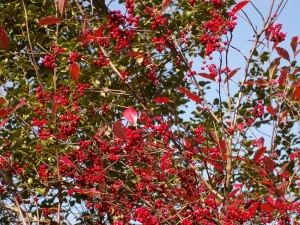Dr. Leonard Perry, Extension Professor
University of Vermont
If you are looking for an easy care, native ornamental plant to add color to the late fall and early winter landscape, consider the winterberry. Also known as winterberry holly or North American holly (Ilex verticillata), this relative of the evergreen hollies is “deciduous” (losing its leaves in winter). It loses its dull green leaves in autumn, leaving an abundance of attractive scarlet berries (orange on yellow on some selections) on every stem and branch. These are attractive in arrangements, or just left in the landscape, if they aren’t devoured by birds.
Native populations of winterberry can be found from the eastern Canadian provinces of Newfoundland and New Brunswick south to Virginia and as far west as Michigan. This shrub is generally found in swampy areas, wet thickets, and low woodlands, and is often seen in masses in such areas from highways. Winterberry can grow up to 10 to 15 feet tall, although they are generally half that height. Cultivars for landscape situations generally range in height from 3 feet up to 6 feet.
Winterberry is hardy for USDA hardiness zones 4 to 9 (to -20F average minimum temperature in winter, or lower), which includes much of New England except for the coldest regions. Plant in full sunlight. This plant prefers acidic to slightly acidic, wet soil– conditions which mimic its natural habitat. Planting it near a pond or stream is perfect. However, it also can be grown in drier soil or partial shade, though may not spread as much.
It is ideal for wildlife landscaping as its dense, twiggy growth provides nesting sites for songbirds. Fruit are eaten by red squirrels, cedar waxwings, catbirds, thrushes, and other birds. It is surprisingly disease-resistant, prone only to occasional leaf spots or powdery mildew.
One thing to keep in mind is that you will need to plant both male and female plants for fruit production. Purchase at least one male plant for every three to four female plants, and plant close together.
You also need to think about placement in the garden as this shrub is at its most attractive stage from September through mid-winter when its branches are covered with brightly colored berries. In summer, this plant has only tiny white flowers. Leaves are pale to dark green and elliptical to round in shape, depending on cultivar.
Many cultivars (cultivated varieties) of winterberry grow well in this part of the country. In trials a few years ago at the University of Vermont, best were ‘Jolly Red’, ‘Maryland Beauty’, ‘Winter Red’, and the hybrid ‘Sparkleberry’.
‘Winter Red’ is a favorite for cutting for arrangements as it is multi-stemmed with an abundance of bright red, medium-sized berries and dark green leaves that turn bronze in autumn. It can grow to nine feet tall. ‘Winter Gold’ has a similar growth habit and produces attractive peach to gold-orange berries that get paler as they age. A good male cultivar for pollinating these is ‘Southern Gentleman”.
For a low hedge or mass planting, choose ‘Red Sprite’ with its tight branching and mature height of only 3 to 5 feet, which you may also find as ‘Nana’. It was the 2010 Holly of the Year of the Holly Society of America. ‘Afterglow’ too is rather low, only reaching about 6 feet at most, and has lovely orange-red berries. ‘Jim Dandy’ is a good male pollinator for these, as well as for the 5-foot ‘Maryland Beauty’, the 8-foot ‘Stoplight’, or the 9- to 10-foot ‘Jolly Red’.
‘Maryland Beauty’ has dense cluster of dark red fruit along stem, developing color early. It is the cultivar often grown commercially for its cut stems, and was Holly of the Year for 2008. ‘Jolly Red’ is an older cultivar, originally from Connecticut, with large berries. ‘Stoplight’ and ‘Hopperton’ are names for the same plant—a newer cultivar with deep red fruit.
‘Sparkleberry’ is a hybrid of the winterberry species with an Asian species, the finetooth holly (serrata), bred in the 1970’s by the USDA. The result is a shrub, 10- to 12-feet high, with young leaves that are plum colored, and large glossy fruit that ripen early. But it is not as hardy (USDA zone 6 reliably, or -10F) as the other winterberries. Use the hybrid cultivar ‘Apollo’ for pollination.
These are only a few of the good winterberries available. Check with your local full service garden center or nursery for their recommendations.
(author’s note: Any videos or ads appearing here, added by WordPress, are not in any way related to nor have been approved by the author.)

